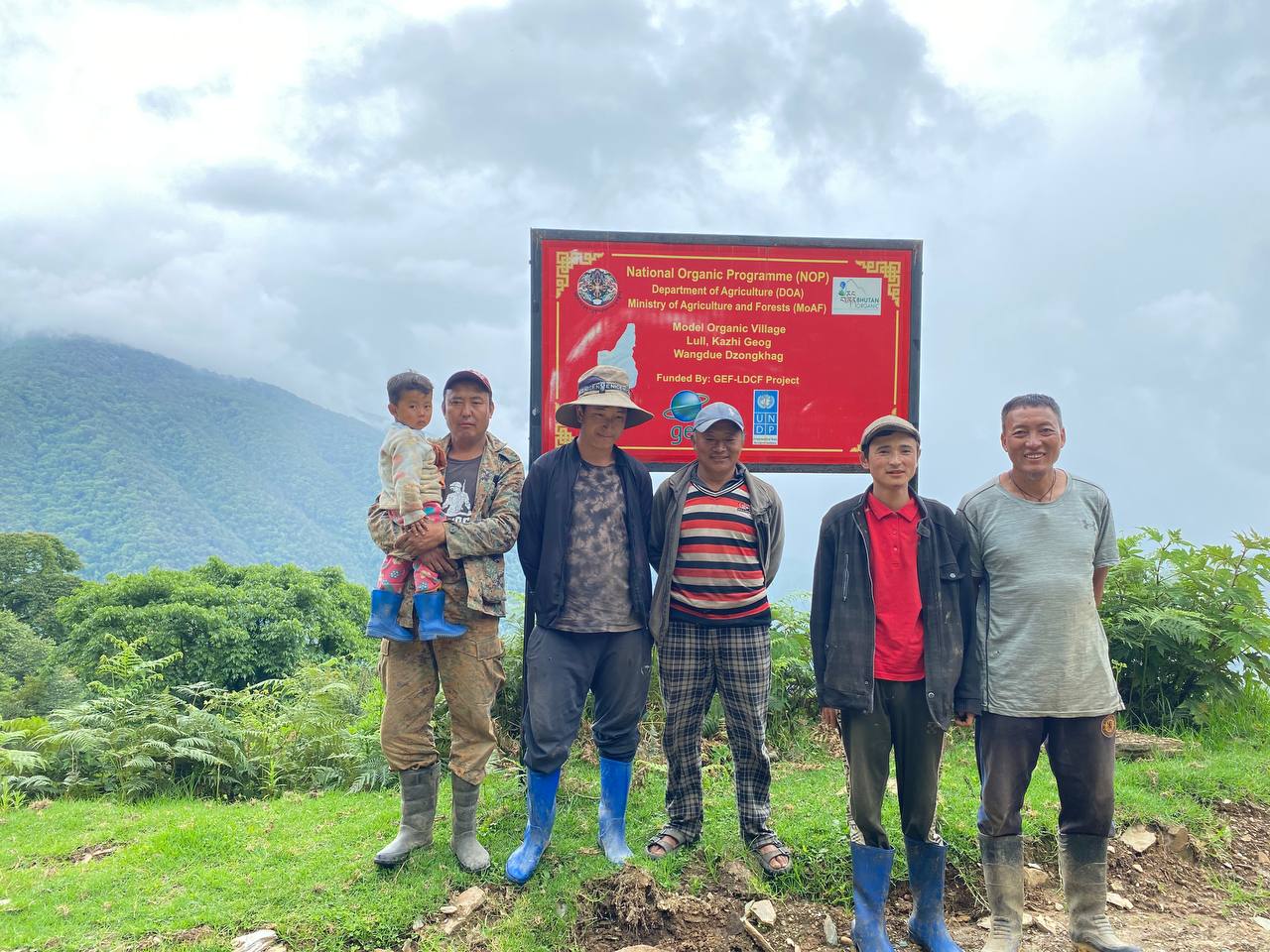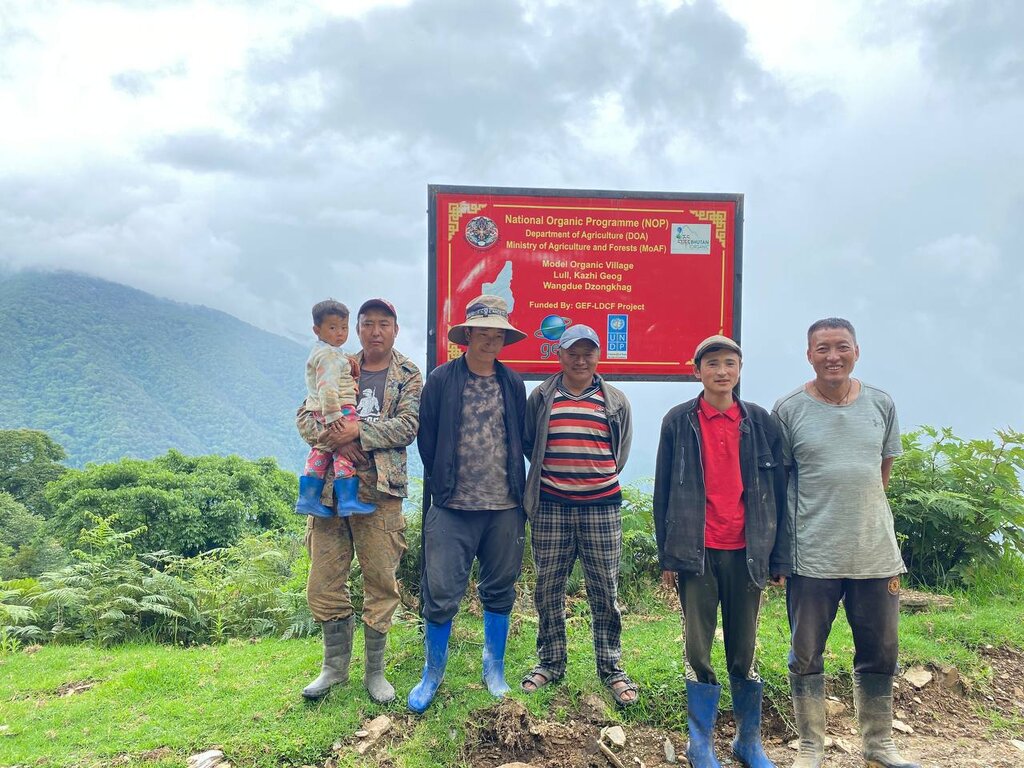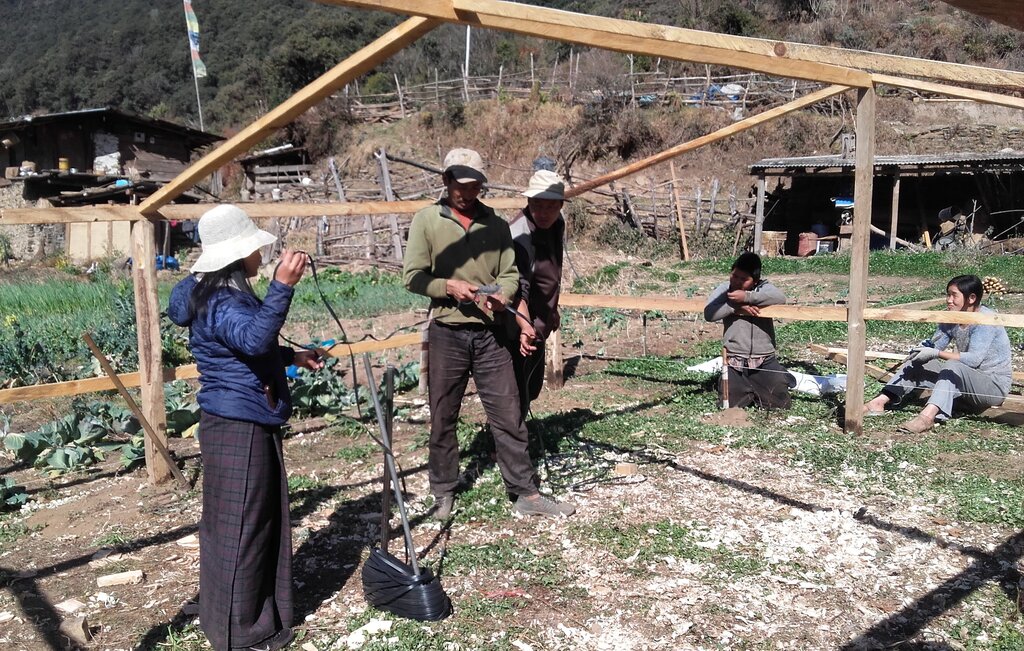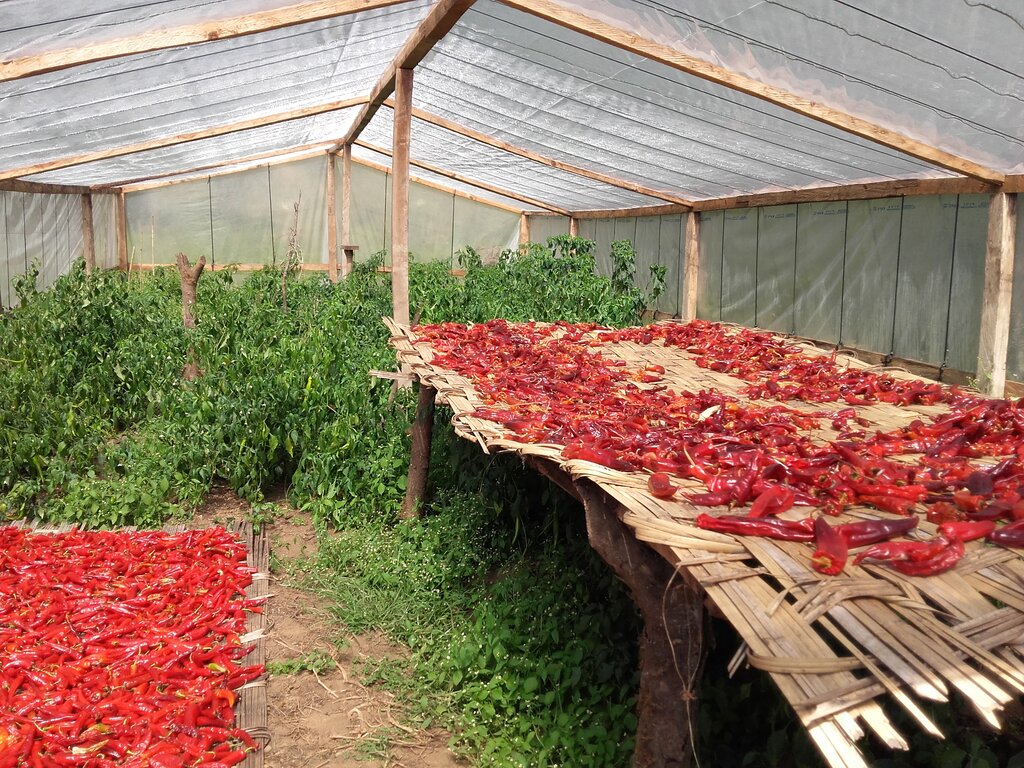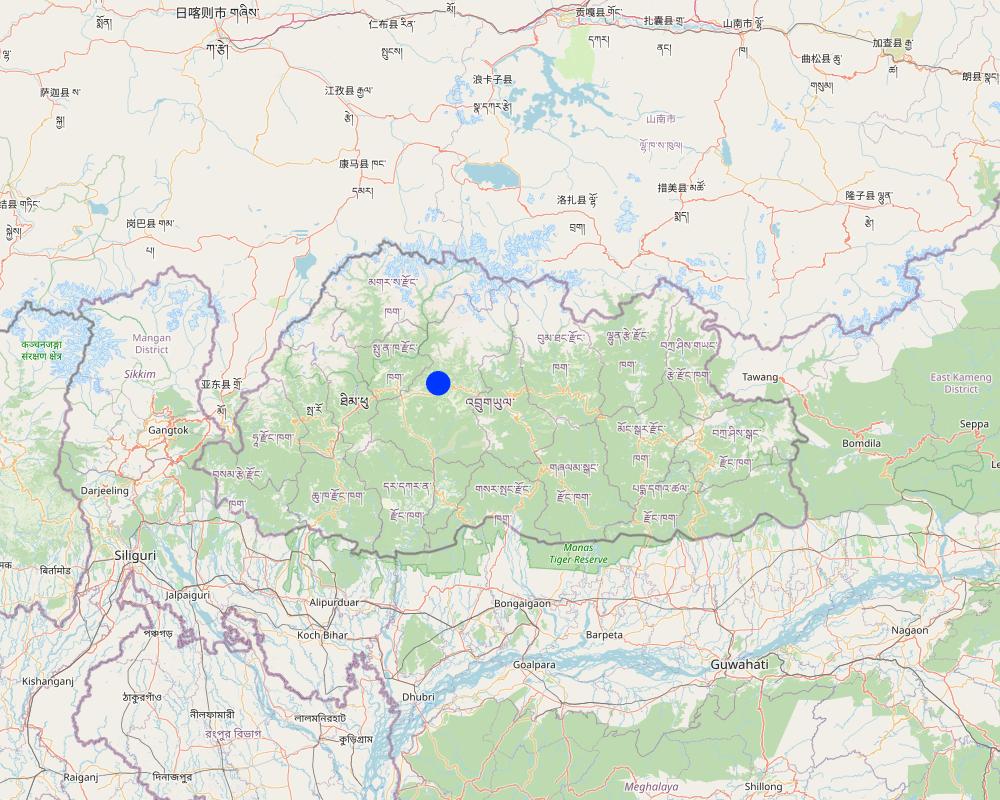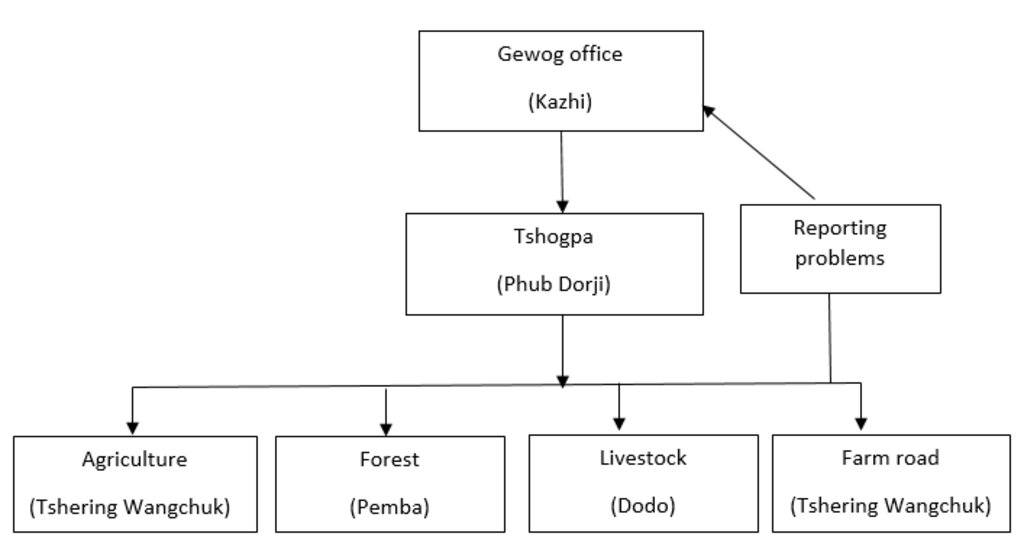Model Village Approach to Scaling Out Organic Agriculture [Bhoutan]
- Création :
- Mise à jour :
- Compilateur : Karma Wangdi
- Rédacteur : chenga Tshering
- Examinateurs : William Critchley, Rima Mekdaschi Studer
Petoen Yue gi Thogley Rangzhin Sanam Jakaed Tangthab (དཔེ་སྟོན་གཡུས་ཀྱི་ཐོག་ལས་རང་བཞིན་སོ་ནམ་བརྒྱ་བསྐྱེད་བཏང་ཐབས།)
approaches_6838 - Bhoutan
Voir les sections
Développer tout Réduire tout1. Informations générales
1.2 Coordonnées des personnes-ressources et des institutions impliquées dans l'évaluation et la documentation de l'Approche
Personne(s) ressource(s) clé(s)
exploitant des terres:
Pemba
17738919
Lull Village, Lengbi Chiwog
Lull village, Lengbi Chiwog Community), Kazhi Gewog (Block), Wangduephodrang Dzongkhag (District)
Bhoutan
exploitant des terres:
Dorji Phub
77330501
Lull Village, Lengbi Chiwog, Kazhi Geog, Wangdue Phodrang
Lull Village, Lengbi Chiwog, Kazhi Gewog, Wangdue Phodrang.
Bhoutan
exploitant des terres:
Dodo
17473224
Lull Village, Lengbi Chiwog (Block), Kazhi Gewog (Block), Wangduephodrang Dzongkhag (District)
Lull Village, Lengbi Chiwog, Kazhi Gewog, Wangdue Phodrang.
Bhoutan
exploitant des terres:
Wangchuk Tshering
17160021
Lull Village, Lengbi Chiwog, Kazhi Gewog, Wangduephodrang
Lull Village, Lengbi Chiwog, Kazhi Gewog, Wangduephodrang.
exploitant des terres:
Wangchuk Tshering
17443965
Lull Village, Lengbi Chiwog, Kazhi Geog, Wangduephodrang
Lull Village, Lengbi Chiwog, Kazhi Gewog, Wangduephodrang.
Bhoutan
Nom du projet qui a facilité la documentation/ l'évaluation de l'Approche (si pertinent)
Strengthening national-level institutional and professional capacities of country Parties towards enhanced UNCCD monitoring and reporting – GEF 7 EA Umbrella II (GEF 7 UNCCD Enabling Activities_Umbrella II)Nom du ou des institutions qui ont facilité la documentation/ l'évaluation de l'Approche (si pertinent)
National Soil Services Centre, Department of Agriculture, Ministry of Agriculture & Livestock (NSSC) - Bhoutan1.3 Conditions relatives à l'utilisation par WOCAT des données documentées
Quand les données ont-elles été compilées (sur le terrain)?
10/07/2023
Le compilateur et la(les) personne(s) ressource(s) acceptent les conditions relatives à l'utilisation par WOCAT des données documentées:
Oui
2. Description de l'Approche de GDT
2.1 Courte description de l'Approche
Organic agriculture includes a variety of farming systems that advance the sustainable production of food and fibres, prioritizing human health, and environmental, social, and economic aspects. The main objective of the model village approach is to promote the commercialization of organic farm produce.
2.2 Description détaillée de l'Approche
Description détaillée de l'Approche:
Organic farming is a system of agricultural production based on the use of natural processes and resources. Organic farming is on the rise worldwide. Until 1961, when chemicals were introduced to Bhutanese farmers, Bhutan was 100% organic. There were no chemicals to buy and no chemicals to use. There were no genetically modified seeds to buy and no genetically modified seeds to use. Farmers were required to weed their field by hands instead of spraying butachlor, a powerful pesticide used in paddy fields. According to Dzongkhag agriculture officer (DAO), a farmer in Wangdue, said that organic agriculture is "what we used to do." Traditional farming methods in Bhutan are organic and the departure from that has been a recent movement. But young farmers who started after the introduction of chemicals cannot remember a time when chemicals were not a part of their farming practices. The increase in chemicals is a recent trend, and depending on which chemical is under consideration the trend has either stagnated or grown. According to the national organic program, the use of fertilizer has remained constant over the last thirty years. On the other hand, the use of synthetic herbicides has grown each year. The primary example of herbicides used are butachlor in rice paddy fields and metribeuzin in potatoes (Hokenson, 2014).
The Department of Agriculture in collaboration with Dzongkhag Agriculture Office and Gewog Administration identified Lull village, Lengbi Chiwog of Kazhi gewog as a "Model Organic Village" to improve the livelihoods of people through crop diversification and income generation. Lull village was identified as an organic village in 2018. The main objective of this approach is to promote the commercialization of organic farm produce through post-production and value addition (Dorji, 2022).
In 2013, 51-year-old Tashi Bidha was the only farmer in Lull, a village situated in the Kazhi gewog region, approximately 40 kilometers from Bajo, Wangdue. The village, comprising a mere eight households, was classified as one of the most isolated in the Wangdue region. Lull is presently the first prosperous organic village in Wangdue. This began in 2013 with the initiative of one individual to establish road connectivity. Phub Dorji, a native of Lull, remarked that the village lacked roads and electricity at the time.
The village's application for road connectivity was rejected in 2013 due to its failure to satisfy the minimum threshold of 20 households. Many were apprehensive when Phub Dorji suggested that they make their own road. Following some deliberation, however, six households reached a consensus. Six households contributed more than Nu.500,000 towards the repair of the 8.8 kilometers of road in Lull. Electricity arrived in the village months after the road was constructed. The community consented to transition to organic practices in 2017.
Wangdue’s agriculture extension stated the village received potato seeds, asparagus seedlings, bio-fertiliser, bio-pesticide and vermicomposting among others. The village has five polyhouses, and they have first-hand training in bio-pesticide preparation. They are now technically equipped. Lull previously cultivated wheat, barley, and chili. The village currently produces more than eleven different types of commodities and distributes its goods in Phuentsholing, Thimphu, Punakha, and Wangdue. Potatoes, garlic, and chili peppers are among the principal cash commodities of Lull. Presently, income generation has increased to Nu 770,000 since the transition to organic practices.
2.3 Photos de l'approche
2.5 Pays/ région/ lieux où l'Approche a été appliquée
Pays:
Bhoutan
Région/ Etat/ Province:
Wangdue phodrang
Autres spécifications du lieu :
Kazhi, Lull village
Map
×2.6 Dates de début et de fin de l'Approche
Si l'année précise est inconnue, indiquez approximativement quand l'Approche a démarré:
il y a moins de 10 ans (récemment)
2.7 Type d'Approche
- initiative/ innovation récente locale
2.8 Principaux objectifs de l'Approche
To improve the livelihoods of people by through crop diversification and income generation while promoting the commercialization of organic farming through post-production and value-addition for independency and self sufficiency.
2.9 Conditions favorisant ou entravant la mise en œuvre de la(des) Technologie(s) appliquée(s) sous l'Approche
normes et valeurs sociales/ culturelles/ religieuses
- favorise
Able to conserve biodiversity and nature resources on farm and in the surrounding environment.
disponibilité/ accès aux ressources et services financiers
- favorise
Increasing income and reducing production cost
collaboration/ coordination des acteurs
- favorise
Integration of traditional knowledge, joint problem solving and farmer to farmer exchange can improve a community relations and lead to greater involvement and commitment of producers.
cadre politique
- favorise
Organic farming policy will help to protect farming communities in the present global situations.
connaissances sur la GDT, accès aux supports techniques
- favorise
Sustainable use of resources ultimately protecting lands and use of organic fertilizers improving soil fertility
- entrave
Less aware to the organic technical knowledge
marchés (pour acheter les intrants, vendre les produits) et prix
- entrave
Higher prices for the organic products leading to low consumer demands and no specific market outlet for organic production.
charge de travail, disponibilité de la main-d'œuvre
- entrave
Extensive labor as organic farm management requires intensive care and monitoring.
autre
- favorise
Environment- Reduces environmental contamination risks and minimises the public health costs of pesticide poisonings, etc.
3. Participation et rôles des parties prenantes impliquées dans l'Approche
3.1 Parties prenantes impliquées dans l'Approche et rôles
- exploitants locaux des terres / communautés locales
Land users
To practice various methods of organic farming
- gouvernement national (planificateurs, décideurs)
National Centre for Organic Agriculture (NCOA)
Provide training on Organic farming practices, Local Organic Assurance Standard, facilitate farm input support, field inspections and certification.
Si plusieurs parties prenantes sont impliquées, indiquez l'organisme chef de file ou l'institution responsable:
Dzongkhag Organic Focal Person, Extension Supervisor and Tshogpa.
3.2 Participation des exploitants locaux des terres/ communautés locales aux différentes phases de l'Approche
| Participation des exploitants locaux des terres/ communautés locales | Spécifiez qui était impliqué et décrivez les activités | |
|---|---|---|
| initiation/ motivation | auto-mobilisation | Lull, an abandoned village before 2013 due to its remote location, has witnessed a revival. Mr. Phub Dorji, the current Tshogpa of Lenbee chiwog from Lull village, has taken the initiative to construct the Lull farm road. He collected contributions for fuel and basic maintenance from beneficiaries, and the Dzongkhag Agriculture Office facilitated the deployment of a CMU Excavator. The construction of a 9.00 km farm road to Lull village was a collaborative effort, gradually connecting with the Dzongkhag and extending further to the National Centre for Organic Agriculture (NCOA). Thereafter, Lull village has been adopted as a "Model Organic Village". |
| planification | soutien extérieur | The Dzongkhag, Gewog, and NCOA have collectively formulated a plan in consultation with land users and submitted a funding request to GEF-LDCF. |
| mise en œuvre | auto-mobilisation | NCOA, Dzongkhag Agriculture Office, Gewog Agriculture Office and Land Users. |
| suivi/ évaluation | passive | The monitoring and evaluation as sited above were in team comprising of representative from NCOA, Dzongkhag and Gewog. Compilation of progress report and submission annually to NCOA, Dzongkhag and Gewog Administration. |
3.3 Diagramme/ organigramme (si disponible)
3.4 Prises de décision pour la sélection de la Technologie/ des Technologies
Indiquez qui a décidé de la sélection de la Technologie/ des Technologies à mettre en œuvre:
- tous les acteurs concernés dans le cadre d'une approche participative
Expliquez:
This approach involves participation of all the relevant stakeholders (Dzongkhag Agriculture Office, Gewog Administration, NCOA, Tshogpa and Land Users)
Spécifiez sur quelle base ont été prises les décisions:
- l'évaluation de connaissances bien documentées en matière de GDT (prises de décision fondées sur des preuves tangibles)?
4. Soutien technique, renforcement des capacités et gestion des connaissances
4.1 Renforcement des capacités/ formation
Une formation a-t-elle été dispensée aux exploitants des terres/ autres parties prenantes?
Oui
Spécifiez qui a été formé:
- exploitants des terres
Si pertinent, spécifiez le genre, l'âge, le statut, l'ethnie, etc.
Both female and male
Formats de la formation:
- entre agriculteurs (d'exploitants à exploitants)
- zones de démonstration
- réunions publiques
Thèmes abordés:
Land users were provided with wide range of training targeting towards organic farming practices. The training was provided on Low Cost Plastic House Construction, Soil fertility Management (Composting & Vermi Composting), Nursery raising & transplanting, Bio Pesticide preparation and application and Post Harvest Management practices focusing on target crops. Further they were also provided with study tour to ARDC Bajo to update on the latest technology targeting on Soil fertility and Bio Pesticide management besides Bio Char preparation.
4.2 Service de conseils
Les exploitants des terres ont-ils accès à un service de conseils?
Oui
Spécifiez si le service de conseils est fourni:
- dans les champs des exploitants?
- dans des centres permanents
Décrivez/ commentez:
Advisory services are provided from Gewog Agriculture Extension Supervisor/ Dzongkhag Organic Focal, ARDC Bajo, National Center for Organic Agriculture (NCOA).
4.3 Renforcement des institutions (développement organisationnel)
Des institutions ont elles été mises en place ou renforcées par le biais de l'Approche?
- oui, modérément
Spécifiez à quel(s) niveau(x), ces institutions ont été renforcées ou mises en place:
- local
- régional
Décrivez l'institution, ses rôles et responsabilités, ses membres, etc.
They are able to produce organic products for their self consumption and also able to supply to other institutions like schools and to the common vegetable markets.
Précisez le type de soutien:
- renforcement des capacités/ formation
- équipement
- Seeds, Bio Fertilizers, Bio Pesticides/Fungicide, Low Cost & Prefabricated Plastic House, Electric Fencing Materials & Grass cutter.
Donnez plus de détails:
Land users were provided with inputs (Improved Seeds, Bio-Fertilizers, Bio-Pesticide and Fungicide) at the initial stage prior to the capacity building. After the training, the inputs that land users can afford were gradually lifted through timely consultation meetings. The crucial inputs that the land users can't afford were included in the plan - and they were supplied with electric fencing materials to mitigate crop depredation from wild pests followed by a grass cutter for timely weed management within and around the field.
4.4 Suivi et évaluation
Le suivi et l'évaluation font ils partie de l'Approche? :
Oui
Commentaires:
Monitoring and evaluation were done during the field visit to assess the physical progress by Extension Supervisor, Dzongkhag Agriculture Office & NCOA followed by consultation meetings where progress are reviewed and new plan were proposed. This progress and plan were finally submitted to NCOA, Dzongkhag Agriculture Office and Gewog Administration annually.
4.5 Recherche
La recherche a-t-elle fait partie intégrante de l’Approche?
Non
5. Financement et soutien matériel externe
5.1 Budget annuel de la composante GDT de l'Approche
Indiquez le budget annuel de la composante GDT de l'Approche en $ US:
4000,00
Si le budget annuel précis n'est pas connu, indiquez une fourchette:
- 10 000-100 000
Commentez (par ex. principales sources de financement/ principaux bailleurs de fonds):
GEF-LCDF
5.2 Soutiens financiers/ matériels fournis aux exploitants des terres
Les exploitants des terres ont-ils reçu un soutien financier/ matériel pour la mise en œuvre de la Technologie/ des Technologies?
Oui
Si oui, spécifiez le(s) type(s) de soutien, les conditions et les fournisseurs:
Funding in the initial set up was provided by GCF-LCDF- which stands for Global Environment Facility-Least Developed Countries Fund
5.3 Subventions pour des intrants spécifiques (incluant la main d'œuvre)
- équipement
| Spécifiez les intrants subventionnés | Dans quelle mesure | Spécifiez les subventions |
|---|---|---|
| machines | entièrement financé | Rice milling machine and other processing machine |
| outils | en partie financé | Green house |
| Electric fencing materials, Grass cutter | entièrement financé | |
Si la main d'œuvre fournie par les exploitants des terres était un intrant substantiel, elle était:
- volontaire
Commentaires:
They are only six households and they carry out labor sharing without any incentives
5.4 Crédits
Des crédits ont-ils été alloués à travers l'Approche pour les activités de GDT?
Non
5.5 Autres incitations ou instruments
D'autres incitations ou instruments ont-ils été utilisés pour promouvoir la mise en œuvre des Technologies de GDT?
Non
6. Analyses d'impact et conclusions
6.1 Impacts de l'Approche
Est-ce que l'Approche a autonomisé les exploitants locaux des terres, amélioré la participation des parties prenantes?
- Non
- Oui, un peu
- Oui, modérément
- Oui, beaucoup
Improved community relationship and led to greater involvement of the stakeholders and commitment of the producer
Est-ce que l'Approche a permis la prise de décisions fondées sur des données probantes?
- Non
- Oui, un peu
- Oui, modérément
- Oui, beaucoup
Land users proposal while planning has been improved from the initial. They can prioritize their needs towards strengthening organic farming.
Est-ce que l'Approche a aidé les exploitants des terres à mettre en œuvre et entretenir les Technologies de GDT?
- Non
- Oui, un peu
- Oui, modérément
- Oui, beaucoup
Organic farming practices improves sustainable use of resources ultimately resulting in conserving natural resources and increasing soil fertility
Est-ce que l'Approche a amélioré la coordination et la mise en œuvre de la GDT selon un bon rapport coût-efficacité?
- Non
- Oui, un peu
- Oui, modérément
- Oui, beaucoup
Improved livelihoods through higher income generation and reduced production cost
Est-ce que l'Approche a amélioré les connaissances et les capacités des exploitants des terres pour mettre en œuvre la GDT?
- Non
- Oui, un peu
- Oui, modérément
- Oui, beaucoup
There is an exchange and learning platform among the stakeholders
Est-ce que l'Approche a amélioré les connaissances et les capacités des autres parties prenantes?
- Non
- Oui, un peu
- Oui, modérément
- Oui, beaucoup
The approach involves a participatory decision making process.
Est-ce que l'Approche a construit/ renforcé les institutions, la collaboration entre parties prenantes?
- Non
- Oui, un peu
- Oui, modérément
- Oui, beaucoup
The group is encouraging and influencing other local communities and has been learning site disseminated through television.
Est-ce que l'Approche a atténué les conflits?
- Non
- Oui, un peu
- Oui, modérément
- Oui, beaucoup
Enhance team work, collaboration and cooperation among community and stake holders
Est-ce que l'Approche a autonomisé les groupes socialement et économiquement défavorisés?
- Non
- Oui, un peu
- Oui, modérément
- Oui, beaucoup
This approach helped financially unstable farmers to improve their livelihood
Est-ce que l'Approche a amélioré l'égalité entre hommes et femmes et autonomisé les femmes et les filles?
- Non
- Oui, un peu
- Oui, modérément
- Oui, beaucoup
No gender bias
Est-ce que l'Approche a encouragé les jeunes/ la prochaine génération d'exploitants des terres à s'engager dans la GDT?
- Non
- Oui, un peu
- Oui, modérément
- Oui, beaucoup
The evidence based learning through hands on training and study tour to ARDC Bajo has encouraged the young people currently in the community while those young students attending during the break and social influence are encouraging the young generations to take up the organic farming in the future.
Est-ce que l'Approche a conduit à améliorer la sécurité alimentaire et/ou la nutrition?
- Non
- Oui, un peu
- Oui, modérément
- Oui, beaucoup
The approach of organic farming provided healthy production leading to improved food security and nutrition.
Est-ce que l'Approche a amélioré l'accès aux marchés?
- Non
- Oui, un peu
- Oui, modérément
- Oui, beaucoup
No specific market outlet for un processed organic product especially fresh vegetables though follow up are being done by Dzongkhag with opening of Organic Market Outlet at Bajo Town.
Est-ce que l'Approche a conduit à améliorer l'accès à l'eau et l'assainissement?
- Non
- Oui, un peu
- Oui, modérément
- Oui, beaucoup
There is no usage of chemical fertilizers resulting in the reduction in pollution.
Est-ce que l'Approche a conduit à l'utilisation/ sources d'énergie plus durables?
- Non
- Oui, un peu
- Oui, modérément
- Oui, beaucoup
This approach is an integrated human, environment and sustainable agriculture production system while reducing external inputs like use of synthetic fertilizers and other harmful chemical pesticide.
Est-ce que l'Approche a conduit à des emplois, des opportunités de revenus?
- Non
- Oui, un peu
- Oui, modérément
- Oui, beaucoup
Young generations are being encouraged to adopt organic production systems
6.2 Principale motivation des exploitants des terres pour mettre en œuvre la GDT
- augmenter la production
Optimum production
- augmenter la rentabilité/ bénéfice, rapport coûts-bénéfices
Low cost of production with reasonable market price of the product.
- prestige, pression sociale/ cohésion sociale
This approach has further improved their cohesion and interaction while every individuals support the responsibility taken by individual assigned.
This community has prestige that no community has. They have nomination of representatives within themself. Suppose for Agriculture, Tshogpa is representative of the group. So rest will provide full support for what ever activities the Tshogpa leads or directs the very reason for the success of Model Organic Village approach.
- conscience environnementale
This approach reduces environmental contamination risks
- coutumes et croyances, morale
This approach preserves old tradition and respects the local culture.
- améliorer les connaissances et compétences en GDT
It helps to maintain higher soil fertility and best use of local resources leading to proper land management
- améliorer l'esthétique
It helps to conserve biological diversity and balance ecosystem.
- atténuer les conflits
For small and poor farmers, organic farming can be an effective risk management tool that reduces input cost, diversifies production and improve local food security
6.3 Durabilité des activités de l'Approche
Les exploitants des terres peuvent-ils poursuivre ce qui a été mis en œuvre par le biais de l'Approche (sans soutien extérieur)?
- oui
Si oui, décrivez de quelle manière:
Organic production encourage long term commitment to maintain soil fertility, particularly addressing soil erosion, degradation and desertification and also reduce external energy consumption and reduce water use
6.4 Points forts/ avantages de l'Approche
| Points forts/ avantages/ possibilités du point de vue de l'exploitant des terres |
|---|
| Low cost of investment and low external input use |
| Higher prices for organic products provide higher earning for producer involved in production, processing and trade hereby benefiting the small farmers |
| Points forts/ avantages/ possibilités du point de vue du compilateur ou d'une autre personne ressource clé |
|---|
| Provide awareness and knowledge among the producers about organic farming techniques |
| Increase international organic market and provide niche export market for Bhutanese farmers that can comply with organic standards |
| Provide a platform for business development in producing organic products and processing high value organic products(manufacturing) |
6.5 Faiblesses/ inconvénients de l'Approche et moyens de les surmonter
| Faiblesses/ inconvénients/ risques du point de vue de l’exploitant des terres | Comment peuvent-ils être surmontés? |
|---|---|
| Labor intensive | Mechanization |
| Lack of knowledge on organic production | Hands on training on organic production |
| Lack of specific market for organic production | Need support policies from high levels |
| Faiblesses/ inconvénients/ risques du point de vue du compilateur ou d'une autre personne ressource clé | Comment peuvent-ils être surmontés? |
|---|---|
| Certification is costly for small farmers and could be a serious barrier to access a market that will require certification in future. | Proper legal framework and policies for farmers with affordable price in future. |
| Limited awareness in the domestic market about nutritional, safety and quality of organic farm produce | More awareness in the market as well as consumers, |
7. Références et liens
7.1 Méthodes/ sources d'information
- visites de terrain, enquêtes sur le terrain
5
- interviews/entretiens avec les exploitants des terres
5
7.2 Références des publications disponibles
Titre, auteur, année, ISBN:
National framework for organic farming in Bhutan, Department of Agriculture, 2006
Disponible à partir d'où? Coût?
website
Titre, auteur, année, ISBN:
Model organic village prospering, Chenga Dorji, 2022
Disponible à partir d'où? Coût?
website, BBS
7.3 Liens vers les informations pertinentes disponibles en ligne
Titre/ description:
Model organic village prospering, Model organic village in Lull chiwog under Kazhi gewog venturing into complete organic farm
URL:
http://www.bbs.bt/news/?p=170622#:~:text=About%20five%20years%20after%20venturing,crop%20diversification%20and%20income%20generation.
Titre/ description:
National framework for organic farming in Bhutan
URL:
https://www.fao.org/faolex/results/details/en/c/LEX-FAOC167577/#:~:text=Bhutan-,National%20Framework%20for%20Organic%20Farming%20in%20Bhutan%2C%202006.,rural%20communities%20%2D%20especially%20poor%20ones.
Liens et modules
Développer tout Réduire toutLiens
Aucun lien
Modules
Aucun module trouvé


